These may look like their meaty cousin, the scotch egg but no, this is a vegetarian scotch egg recipe!

They're made from a lightly spiced blend of beans and chickpeas and they're surprisingly easy to make.
You'll simply mash a selection of tinned beans together, flavour with ginger, chilli and coriander, and then form into four thin patties. You'll then place a lightly boiled egg in the centre of each patty and gather the mixture up to form a casing around each egg.
A quick dip in flour, egg and breadcrumbs and your vegetarian scotch eggs are ready to fry to golden perfection! Don't worry, I've included super detailed step-by-step instructions, with photos for every stage so that you're sure to get fantastic results.

This wonderful recipe is by TV chef Andy Bates who you might recognise from the Food Network. It features in his first cookbook, Modern Twists on Classic Dishes and is just one o a host of simple, hearty British recipes that Andy puts his own twist on.
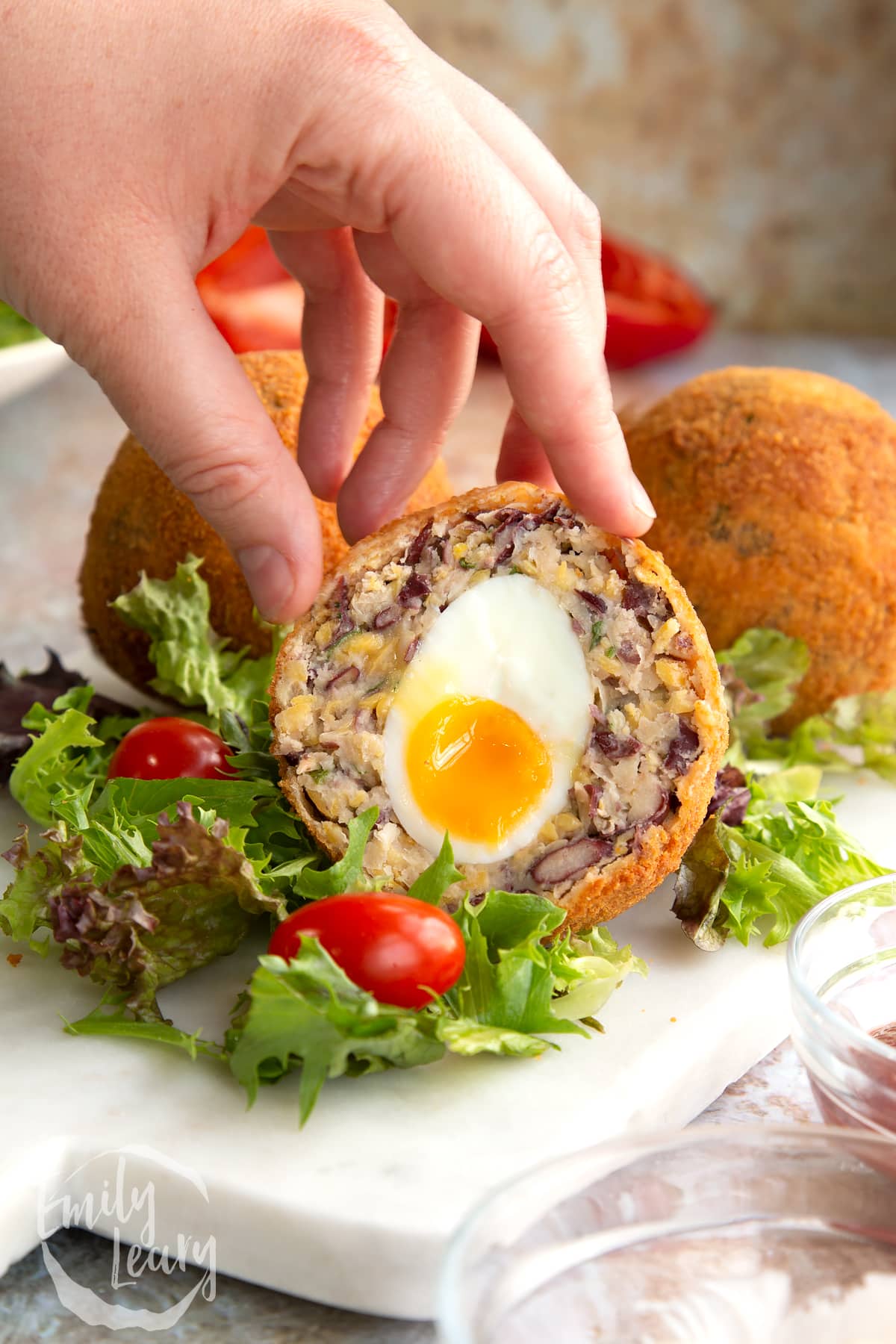
We love making this vegetarian scotch egg recipe. It's perfect for picnics and fabulously tasty. Here's the full recipe - I hope you love them too!
Ingredients
- 4 large free range eggs
- 400 g canned chickpeas (garbanzo beans) rinsed and drained
- 400 g canned red kidney beans rinsed and drained
- 400 g canned white cannellini beans rinsed and drained
- 10 g fresh coriander roughly chopped
- 2 tsp fresh ginger peeled and finely chopped
- 1 fresh chilli deseeded and finely chopped
- Pinch salt and black pepper
- 125 g plain white flour (all purpose flour) all purpose flour
- 2 medium free range eggs beaten
- 1 tbsp whole milk
- 200 g dried white breadcrumbs
- vegetable oil canola oil, for deep frying
Equipment
- Deep fat fryer or suitable high-sided saucepan
- 2 plates
Instructions
Place the eggs, still in their shells, in a pan of boiling water, simmer for 6 minutes. Drain and cool the eggs under cold running water, then peel.

For the filling, drain the canned beans and chickpeas, and rinse thoroughly in cold water and pop into a bowl.

Mash them together, creating a coarse mix.

Add the coriander, ginger, chilli and a pinch of salt and pepper.

Give everything a good mix, then take a small spoonful of the mixture and taste it. Make sure you’re happy with the seasoning and adjust as necessary.

Divide the bean mix into four equal portions.
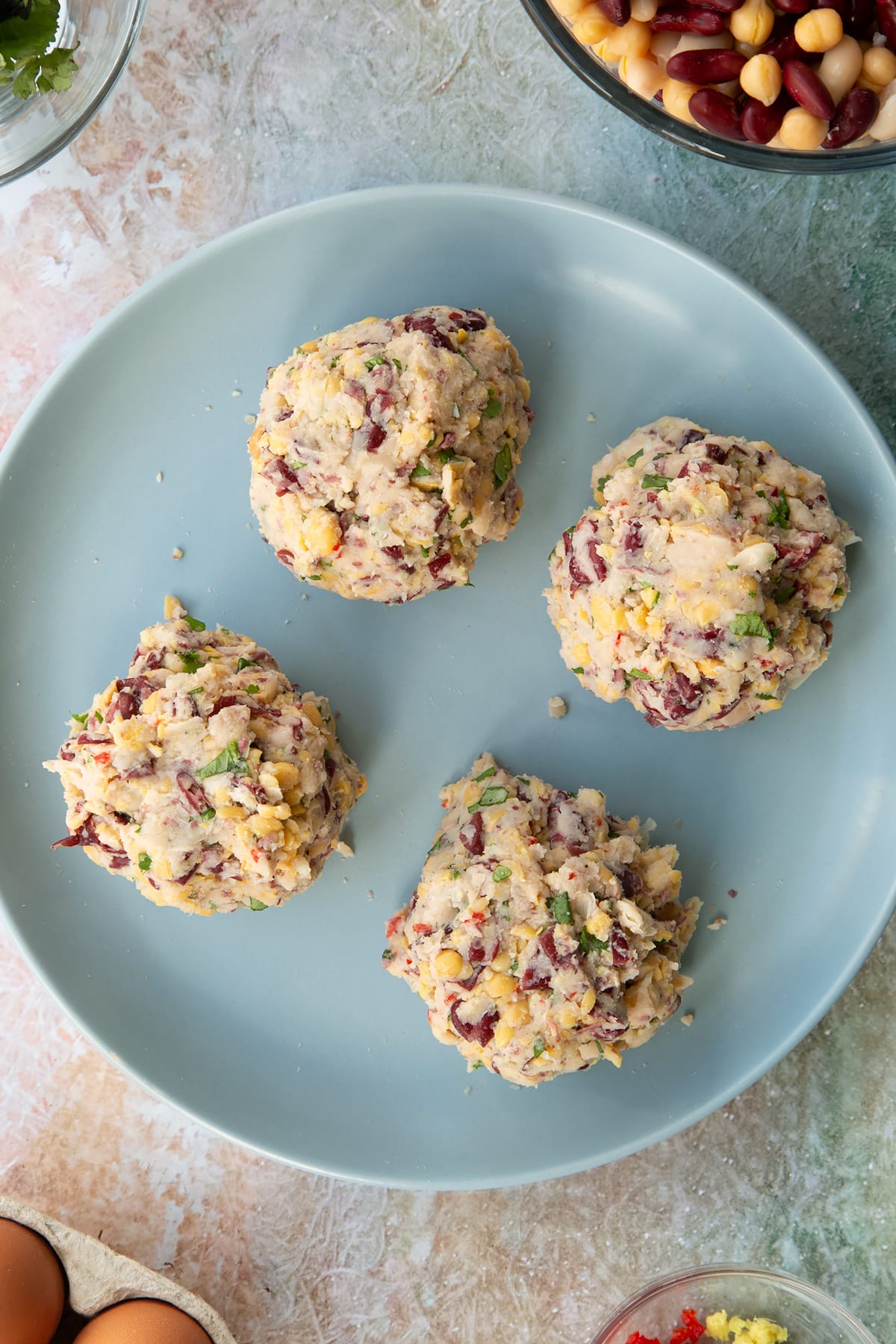
Put a square of clingfilm on a flat surface and flatten out a portion of bean mix into an oval about 12.5cm (5 inches) long and 7.5cm (3 inches) at its widest point.
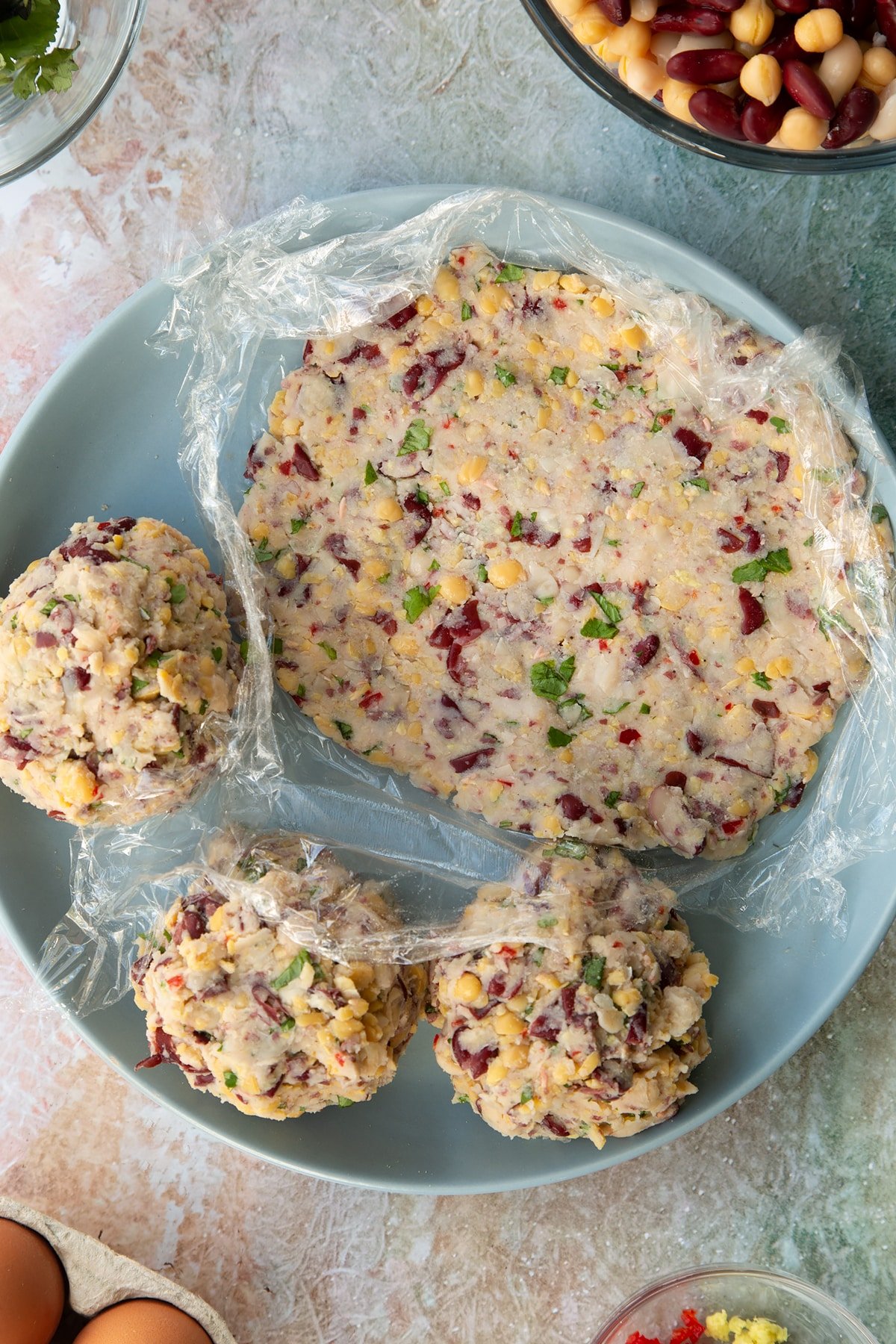
Place an egg onto the bean mix oval.

Pick the cling film square up by its corners, and use it to wrap the mix around each egg. Make sure the coating is smooth and completely covers the egg - any gaps or thin spots may cause cracks during frying.

Repeat until all four eggs are wrapped in bean mixture. You can reuse the same square of cling film for each egg.
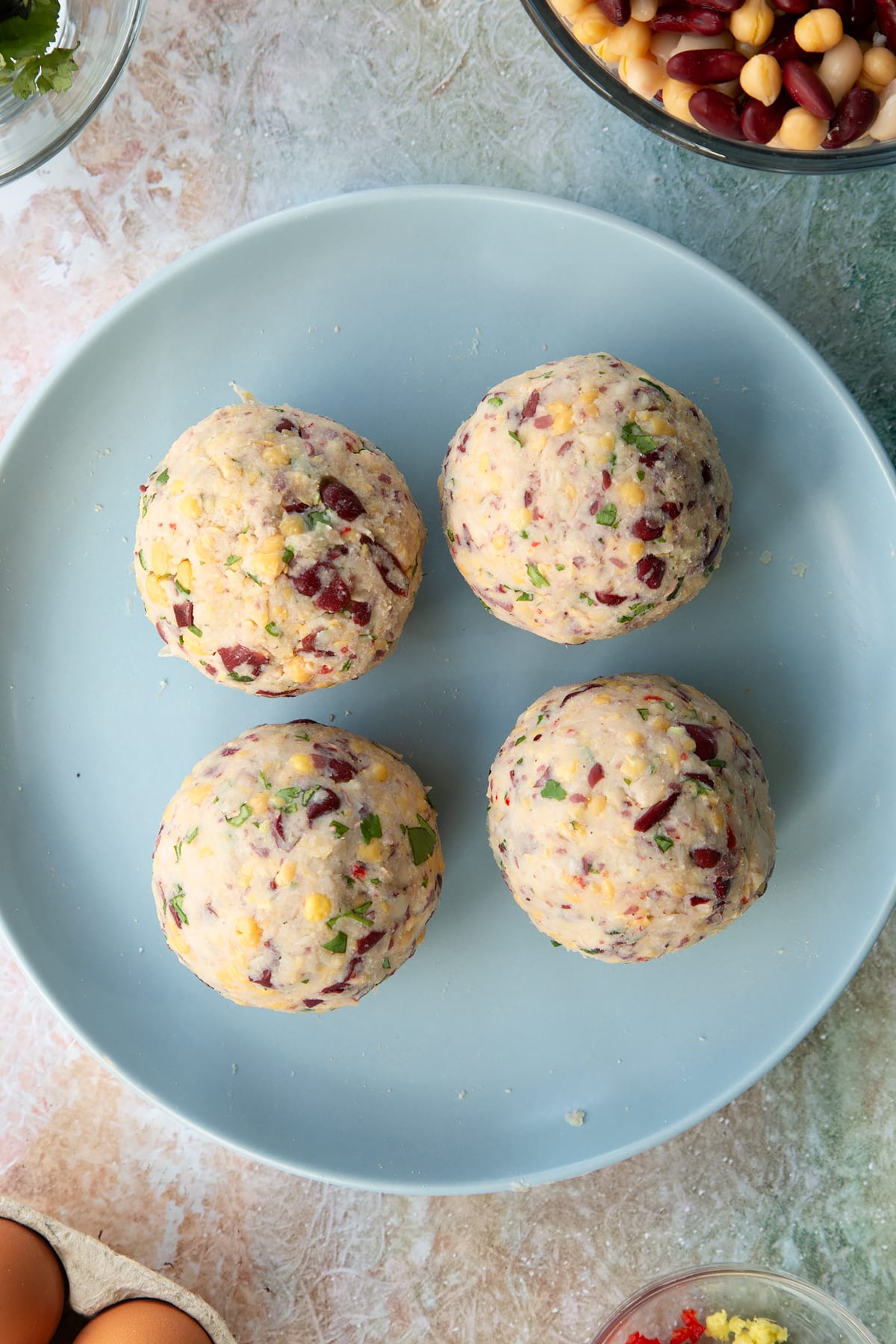
Now prepare a crumbing station. Beat the eggs and milk together in a small bowl. Put the flour on a plate, seasoned with a pinch of salt and pepper, and put the breadcrumbs on a second plate.

Take a bean-wrapped egg and roll first in the beaten egg...

Then the flour.

Then into the beaten egg again.

And finally into the breadcrumbs.

Making sure everything is well coated at every stage.
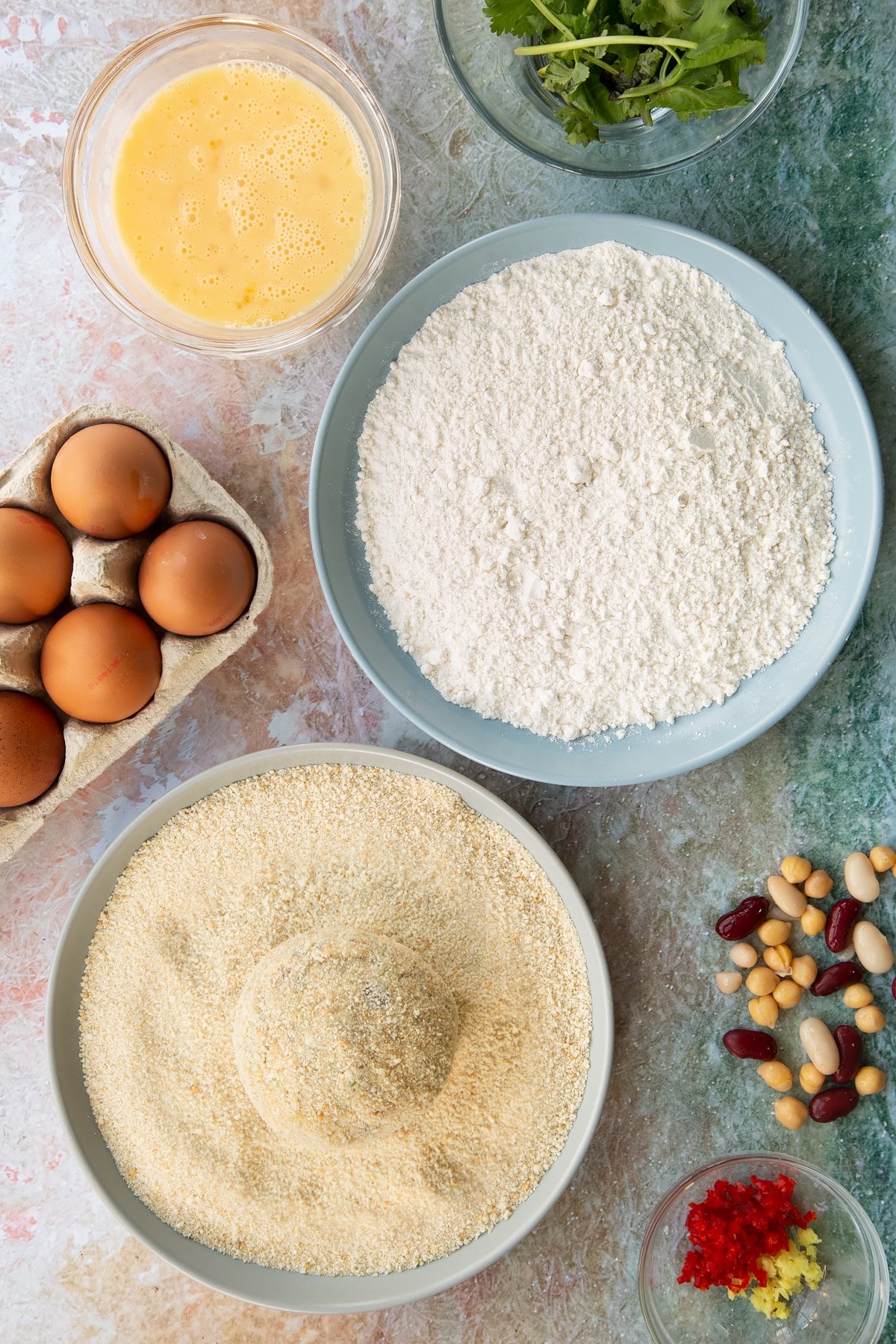
Repeat until all four are coated in breadcrumbs.
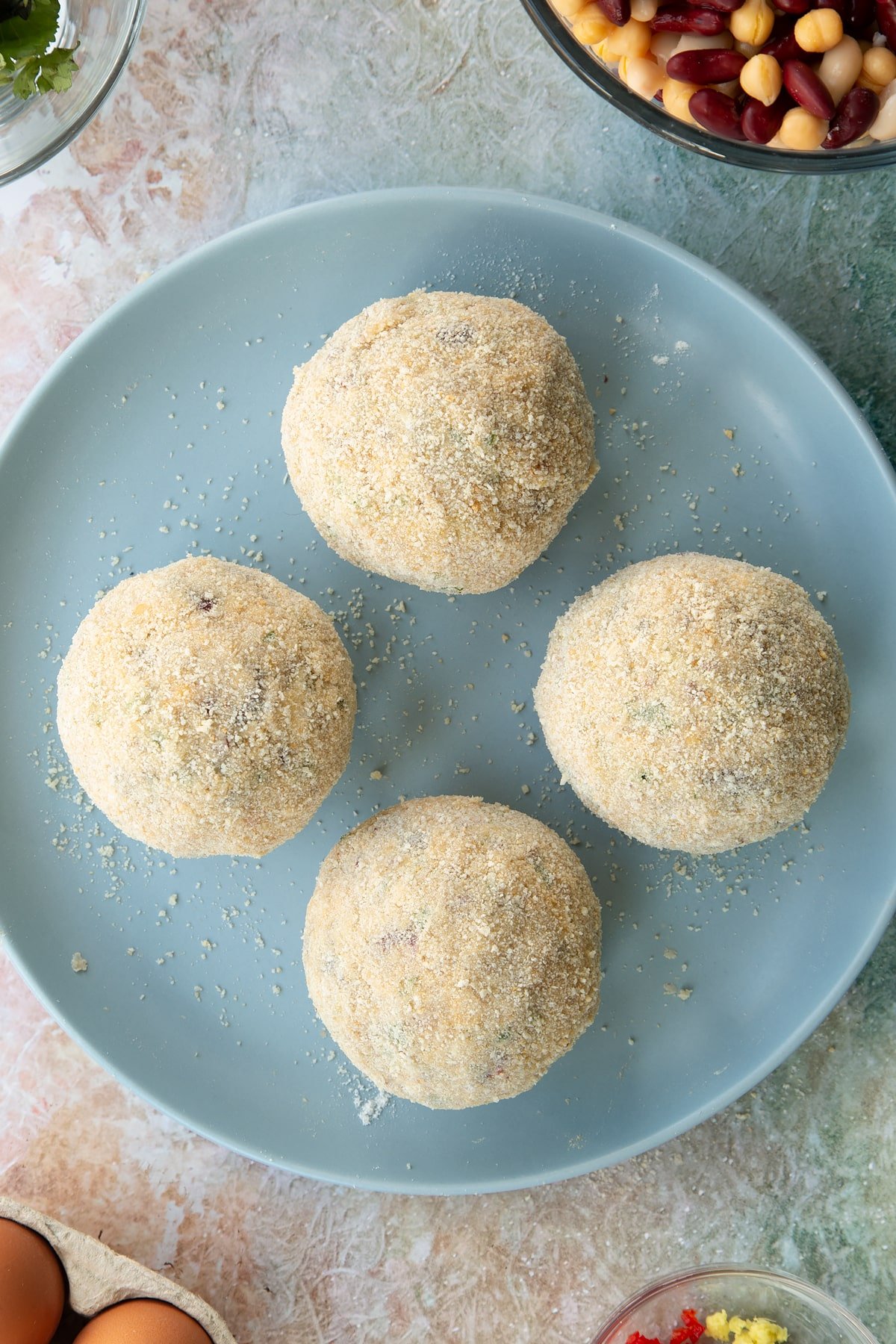
Fill a large pan one third full with oil and heat to 180C (355C). Fry one or two at a time to avoid overcrowding the pan. Lower them carefully into the oil with a spider or slotted spoon.
Deep-fry the eggs for 7-8 minutes, carefully turning as necessary until golden and crisp.
Carefully remove from the cooked eggs oil with a slotted spoon or spider and drain on kitchen paper. A sprinkle of salt as soon as they come out of the oil will help them crisp up.

Allow to rest for 5 minutes before serving.
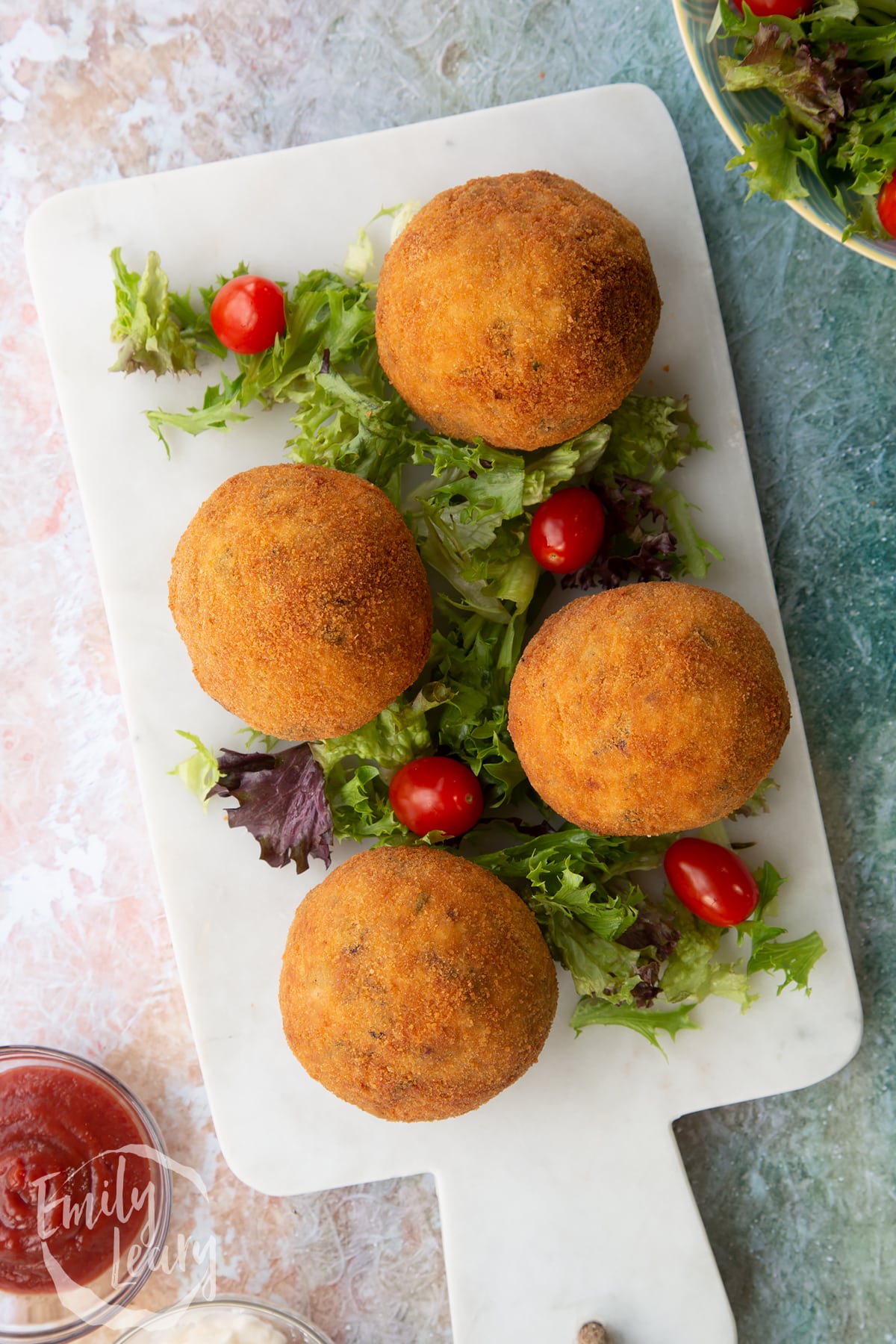
And if you're suitably impressed with Andy's recipe skills, I'd also recommend checking out his new series, American Street Feasts which is currently airing weekdays at 12.30pm and 6.30pm on Food Network.

Pointers, tricks and troubleshooting tips for the perfect Vegetarian Scotch egg recipe
Is this Vegetarian Scotch egg recipe easy to make?
Despite the long ingredients list, this Vegetarian Scotch egg recipe is easy to make. You’ll just need to make sure you have a reliable kitchen timer so you don’t overcook your egg!
As with all my recipes, I’ve included some step by step instructions with photos for each step. So if you get lost, you can check the photos to see if your Scotch eggs look like they’re on the right track.
Will I need any special equipment to make this Vegetarian Scotch egg recipe?
To make this recipe you’ll need only standard kitchen equipment. So if you have all the ingredients in, you can start right now!
For example, you’ll need bowls and a potato masher for mixing and mashing the bean coating. Some measuring scales/spoons for weighing your ingredients. Then just some utensils and a frying pan to fry the Scotch eggs. If you have a deep fat fryer it would help to make frying your Scotch eggs easier, but you can just use a deep saucepan.
There's always a complete list of suggested equipment on the recipe card below my recipes if you're in doubt. In addition, I always include links to example products, to show exactly what I used to make each recipe.
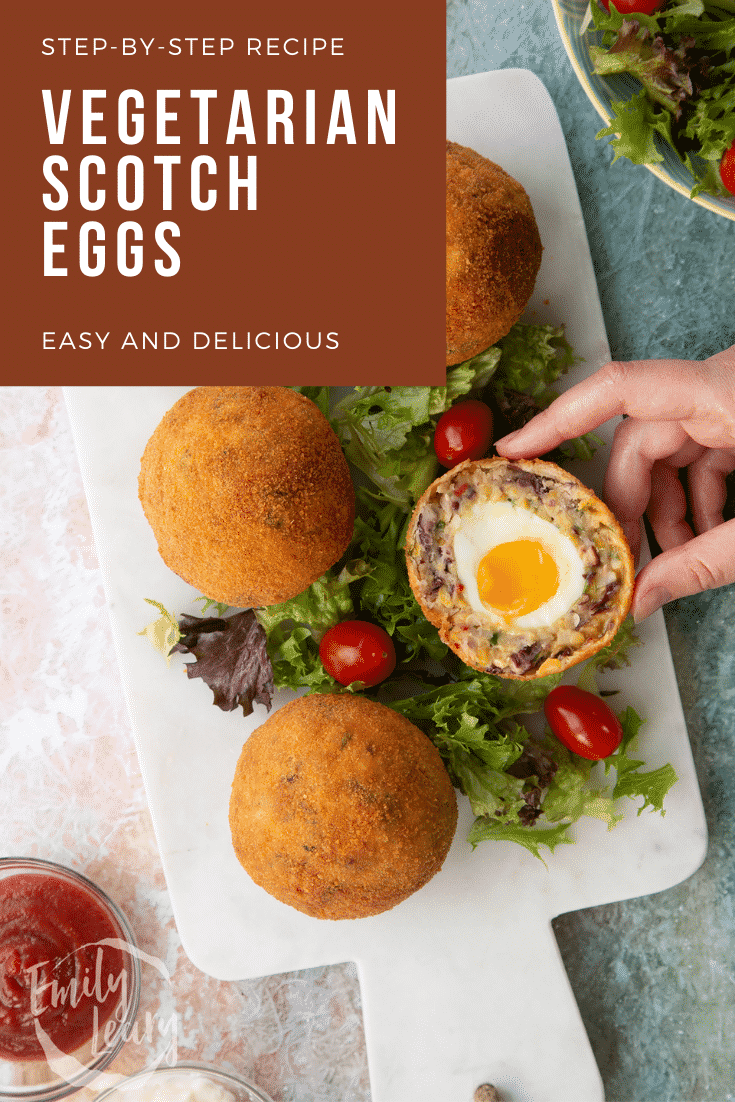
Are there other kinds of Scotch eggs?
Scotch eggs are very popular in the UK. In recent years they’ve gone from a basic snack to a ‘Gastropub modern classic’.
As a result of its glow up from a humble staple to an aspirational foodie favourite, there are now tons of variations on the format.
For example, you can get a Breakfast scotch egg with bacon inside it. Or a Mexican Scotch egg, spiced with chipotle. Or a Spanish inspired Chorizo Scotch egg.
There are even regional variations including the Manchester egg, which uses Bury black pudding instead of sausage meat.
And there are even some recipes that use a cornflake coating on the Scotch egg instead of breadcrumbs.
It’s a great format to experiment with, which is why I made this Vegetarian version!
How do I get a runny yolk in my Scotch egg?
To make sure your Scotch egg is perfectly runny, it’s critical that you only boil your eggs for 4-6 minutes. Then you need to make sure that you completely cool the eggs under cold water from the tap.
If you don't cool the eggs down, the residual heat will continue to cook the yolks, meaning you won’t end up with lovely runny egg yolks.
How can I tell if eggs have gone off?
It's essential to use fresh eggs for this Vegetarian Scotch eggs recipe, as eggs can behave differently in recipes as they get older and their quality declines.
Eggs lose water content the older they get, which means an older egg will be thicker. So not only is it safer to use fresh eggs, but it will improve the quality of your Scotch eggs.
You should never eat an egg that looks, smells, feels or tastes odd in any way. So if your egg has any discolouration, odd appearance, or a strange or foul odour, it is most likely rotten.
Check your eggs are fresh and stored correctly
If you aren't sure if your eggs are fresh, you drop your egg into a cup or bowl of water to see if it sinks or floats. If it floats it has excess gas, meaning it is bad or spoiling. However, sometimes a bad egg can still sink.
So to ensure you don't contaminate a recipe with a bad egg, it's always best to crack your eggs into a separate bowl or cup before adding them to a recipe.
To avoid your eggs spoiling, you should always follow the storage instructions on the egg packet. In the UK, it's recommended that eggs are kept consistently below 20C, which means it's best to keep them in the fridge at home.
Egg safety standards can vary depending on where you live, so storage and use advice can differ too. So make sure you consult your local advice for the best way to keep your eggs as fresh and safe as possible.
If your egg has spoiled, you should immediately throw it away and thoroughly wash any pots and utensils that have come into contact with it.
Egg safety is crucial if you're cooking for someone in a vulnerable or at-risk group, such as older people, people living with health conditions, or a pregnant person.
A Mummy Too does not give medical advice. Please consult with your medical professional.

How can I tell if my butter has gone off?
When butter spoils, it turns to a dark yellow. When it is very spoiled it will also develop areas with translucent patches. Spoiled butter can also develop a layer of condensation on it as water escapes.
These changes occur when bacteria cause the fat, protein and liquid molecules to separate from each other. The lactic acid released during this process can also produce a sour smell and give the butter a fizzy quality.
Sometimes spoiled butter can look completely fine, so you should taste it before including it in a recipe. If it tastes/feels fizzy, it isn't safe to use.
Butter storage
Your butter should be within the Use By date when you use it. However, that date is void if you don’t store your butter correctly. So if you haven’t kept your butter in a sealed container in the fridge and free from crumbs or other contaminants, then it will spoil quicker than the Use By date.
Modern homes with central heating are too warm to keep butter in a butter dish on the counter. So always keep butter in the fridge, well wrapped in the wrapper it came in or in a sealed container.
Is this Vegetarian Scotch egg recipe suitable for vegetarians?
The clue is in the name! Yes, this Vegetarian Scotch egg recipe is completely vegetarian! The ingredients are all naturally meat and fish free, so you shouldn’t need to worry about any accidental addition to the ingredients as I can’t see why they would put meat in beans, eggs or flour
Manufacturers use animal-derived products to thicken, colour or flavour sweet and savoury food, so it sneaks into the most unexpected ingredients! So always make sure that you double-check all of your ingredients labels for any sauces or sides you plan to serve with your Scotch eggs to ensure that they are vegetarian.
Is this Vegetarian Scotch egg recipe suitable for vegans?
No, but you could use a falafel instead of the egg for the centre. For the egg used as a binding agent in the coating, you could use a pre-prepared vegan egg replacement.
Brands like Oggs are available in most UK supermarkets, but there are other brands available. And of course, you can always find vegan egg replacers on Amazon or from online vegan food stores.
Manufacturers use animal-derived products to thicken, colour or flavour sweet and savoury food, so it sneaks into the most surprising ingredients! So always make sure that you double-check all of your ingredients labels to ensure that they are vegan. Also, don't forget to check anything extra that you intend to serve with your recipe.
Is this Vegetarian Scotch egg recipe gluten-free?
This recipe uses flour and breadcrumbs in the coating, but you could use gluten-free versions and it wouldn’t affect the quality.
In the UK, brands like Paxo make their own gluten-free breadcrumbs, but there are brands available worldwide including Schar’s gluten-free breadcrumbs. You’ll usually find gluten-free breadcrumbs on the Free From aisle in supermarkets, or sometimes with gravy, stuffing and sauces - or even the baking aisle. If you can’t find any in-store you can always find what you need from an online store or by ordering your groceries online from a supermarket.
Double-check all of your ingredients labels to make sure that they are gluten-free. Don't forget to check anything extra that you intend to serve the recipe with.
Is this Vegetarian Scotch egg recipe keto-friendly?
Unfortunately, these Vegetarian Scotch eggs have around 78g of carbs per serving, which is higher than the allotted 50g daily maximum allowed on a ketogenic diet.
However, you may be able to reduce the number of carbs by using keto flour as an alternative to breadcrumbs and using beans with lower carbohydrate content.
Is this Vegetarian Scotch egg recipe healthy?
This Vegetarian scotch egg recipe is full of protein and is lower in fat than a standard Scotch egg. However, it is also deep-fried. While the Scotch eggs shouldn’t absorb much oil while cooking them, in general, cooking food in oil does add fat.
But overall, these Vegetarian Scotch eggs are mainly beans and eggs which are high in protein, pretty low in fat and have no sugar.
Is it safe to have a runny Scotch egg?
In the UK, most eggs sold in supermarkets and grocery stores are produced to the British Lion standard.
This means that the hens that lay the eggs are vaccinated against Salmonella and eggs are produced in hygienic and strictly regulated conditions. So because of this process, British Lion eggs are safe to eat runny or even raw! (As long as they are in date and stored correctly)
So if you have eggs produced to the British Lion standard, it should be perfectly safe to have a runny egg in your Vegetarian Scotch egg, even for pregnant people.

Is this Vegetarian Scotch egg recipe safe to eat while pregnant?
As I said above, in the UK it’s safe to eat runny or even raw eggs with the British Lion stamp. So as long as you use fresh British Lion eggs, and you store them correctly, these Scotch eggs should be safe for a pregnant person.
However, this may not be the case for eggs produced outside of the British Lion regulations or from outside the UK, so you should check your local advice.
Eggs can carry salmonella, which isn’t typically life-threatening - it would just make a healthy person very sick, but it is particularly dangerous to pregnant people and those in vulnerable groups.
So you should never risk it when it comes to egg safety. If you need any further advice, find your local health or food safety authority (e.g. the FDA)
Make sure that all of your ingredients are in good condition and that you prepare this meal safely and hygienically.
A Mummy Too does not offer medical advice. Please seek help from a medical professional if you need further information or have any concerns.
What goes well with this Vegetarian Scotch egg recipe?
You can enjoy your Vegetarian Scotch eggs just like a meat Scotch egg. However, make sure you serve them with something vegetarian. Further down this section, I have a list of ways you can serve your Scotch eggs for different occasions. But you can never go wrong with some salad and chutney or hot sauce!
Can I make the Vegetarian Scotch egg recipe without egg?
Sure, check the vegan section above for more advice on making eggless Scotch eggs. Feel free to use any sort of filling which works for you. For vegans I suggest falafel, but use your imagination!
How should I store this Vegetarian Scotch egg recipe?
The best way to store your Vegetarian scotch eggs is to keep them in a sealed container in the fridge. The eggs in your Scotch eggs need to be refrigerated to keep them safe to eat and to stop them from spoiling.
How long will this Vegetarian Scotch egg recipe keep?
You should eat soft boiled Scotch eggs on the day of cooking. Storing a soft boiled egg can be dangerous as it's an ideal home for bacteria. If you boil your eggs for 7-8 minutes they should be hard-boiled after you deep fry the whole Scotch egg.
You can store hard-boiled Scotch eggs in the fridge for 4-7 days. Though they will get soggier the longer you leave them, so eat them ASAP!
Can I leave this Vegetarian Scotch egg recipe out on the counter?
No, if you leave your Vegetarian Scotch eggs on the counter then they will become dangerous to eat or spoil within a few hours. This is because the egg yolk inside is runny.
Despite British Lion eggs being safe to eat raw, it’s not a good idea to eat any runny egg after it has been left out and exposed to any potentially harmful bacteria.
Can I make this Vegetarian Scotch egg recipe ahead?
This recipe is best made on the day you plan to serve it, as the eggs will become soggy and crack apart the longer you store them. Equally, you can’t keep runny eggs, so you would have to hard boil your eggs to store them ahead of time.
Can I keep this Vegetarian Scotch egg recipe in the refrigerator?
You can keep your Vegetarian Scotch eggs in the fridge for up to a week, as long as you hardboil the eggs. It’s too risky to store runny eggs, as they’re a perfect breeding ground for bacteria, even when produced to the British lion standard.
If you want to keep your hardboiled Vegetarian Scotch eggs, you can pop them into a sealed container or lunchbox and refrigerate them for up to a week. Though they will most likely become soggy over time. So it’s best to enjoy them fresh.
Can I freeze this Vegetarian Scotch egg recipe?
No, once thawed your eggs would have a weird and unpleasant texture. So it's best to eat them fresh or keep hard-boiled Scotch eggs in the fridge for up to 7 days.
What is the best way to defrost this Vegetarian Scotch egg recipe?
As I said, you can’t freeze your Vegetarian Scotch eggs as they would be highly unpleasant to eat once thawed.
Can I make this Vegetarian Scotch egg recipe in a different quantity?
If you want to make more or less of this recipe then go right ahead. I think the best way to change the quantity of cake pops the recipe produces is to use a free online recipe calculator.
There are many free recipe calculators available online, so just google ‘free recipe calculator/converter’.
You may want to test that one of the measurements from the calculator is correct before you commit to the results. Just in case the calculator is incorrect due to issues with the website.
Or you can manually calculate the ingredients with a calculator. For example, this Vegetarian Scotch egg recipe makes 4, so if you want to make 8 just multiply each ingredient by 2. Or if you want to make 2, divide the ingredients by 2.
Can I make this Vegetarian Scotch egg recipe in a stand mixer such as a KitchenAid or Kenwood Mixer?
Nope! There’s no point in this recipe that would require a stand mixer.
Can I make this Vegetarian Scotch egg recipe with a food processor?
If you find using a potato masher difficult or have a weakened grip, you could use a food processor to blitz your beans into a coarse mixture. Take care not to blitz them into a paste though.
Try 5-second blasts and check on it between each mix until it looks like the pictures in the recipe above.

Why did my Vegetarian Scotch egg recipe turn out crumbly/cracking apart?
If your Vegetarian Scotch eggs are cracking and crumbly, then it sounds like your bean coating was uneven or had gaps.
Unfortunately you won’t be able to repair them, so next time make sure that you coat your eggs evenly and ensure there are no gaps before you coat them in the egg/ flour/ breadcrumbs. The cracks occur when oil works its way into any gaps and expands them.

How can I add/change the flavours in this Vegetarian Scotch egg recipe?
If you want to add to or change the flavours in this Vegetarian Scotch egg recipe, the best place to do so is in the filling. As I mentioned above, there are many kinds of Scotch eggs but most of these variations change the filling around the egg to create a new take on the classic.
For this recipe, you could try adding some smoked paprika (2-3 teaspoons) to the bean mixture for a smoky flavour. Or you could even try using some curry powder and cumin, for a sort of Coronation chicken inspired egg. Curry powder would work well with the coriander and ginger too.
Or you could take a different route and try using herbs like thyme and rosemary. Both go well with scrambled eggs, so they should work with this recipe beautifully.
Where is the origin of Scotch eggs?
Despite the name, one of the earliest claims for the invention of Scotch eggs comes from the London department store, Fortnum & Mason.
It's thought that Scotch eggs were created sometime before the early 1800s, as this was when the first known reference to them is documented.
Many food historians believe that Scotch eggs were inspired by Koftas (an Indian dish).
A Kofta is similar to a meatball, though there are vegetable and meat versions in various Indian recipes, and they're usually served in a sauce. This inspiration would make sense, as Indian food has had a major influence on many classic British dishes.
Some sources believe that the name isn't a reference to Scotland but the original cooking method or seller - as some believe Scotch eggs were first sold by a delicatessen named Scott & Sons.
Finally, to add further confusion, over the years, Scotch eggs have been known by the much cuter names, "little bird's nests" or "egg balls" in Europe and Scotland.
Ideas for occasions to make Vegetarian Scotch eggs
- Picnics - Scotch eggs are a classic picnic treat, in fact, some stores even sell them as ‘Picnic eggs’.
- Parties - A dish full of Scotch eggs is a perfect party treat for kids or adults. It’s a small, portable and relatively mess-free snack. So you and your carpet can relax!
- High protein snacks - This Vegetarian Scotch egg recipe is packed full of protein thanks to the eggs and beans. So you could make a batch of (hardboiled) Scotch eggs and keep them for snacks or lunch boxes throughout the week.
Print this vegetarian scotch egg recipe
Vegetarian Scotch Egg Recipe
Ingredients
- 4 large free range eggs
- 400 g canned chickpeas (garbanzo beans) rinsed and drained
- 400 g canned red kidney beans rinsed and drained
- 400 g canned white cannellini beans rinsed and drained
- 10 g fresh coriander roughly chopped
- 2 tsp fresh ginger peeled and finely chopped
- 1 fresh chilli deseeded and finely chopped
- Pinch salt and black pepper
- 125 g plain white flour (all purpose flour) all purpose flour
- 2 medium free range eggs beaten
- 1 tbsp whole milk
- 200 g dried white breadcrumbs
- vegetable oil canola oil, for deep frying
Equipment
- Deep fat fryer or suitable high-sided saucepan
- 2 plates
Instructions
- Place the eggs, still in their shells, in a pan of boiling water, simmer for 6 minutes. Drain and cool the eggs under cold running water, then peel.
- For the filling, drain the canned beans and chickpeas, and rinse thoroughly in cold water. Pop into a bowl.
- Mash them together, creating a coarse mix.
- Add the coriander, ginger, chilli and a pinch of salt and pepper and mix. Take a small spoonful of the mixture and taste it. Make sure you’re happy with the seasoning and adjust as necessary.
- Divide the bean mix into four equal portions.
- Put a square of clingfilm on a flat surface and flatten out a portion of bean mix into an oval about 12.5cm (5 inches) long and 7.5cm (3 inches) at its widest point.
- Place an egg onto the bean mix oval, then pick the cling film square up by its corners, and use it to wrap the mix around each egg. Make sure the coating is smooth and completely covers the egg - any gaps or thin spots may cause cracks during frying.
- Repeat until all four eggs are wrapped in bean mixture. You can reuse the same square of cling film for each egg.
- Now prepare a crumbing station. Beat the eggs and milk together in a small bowl. Put the flour on a plate, seasoned with a pinch of salt and pepper, and put the breadcrumbs on a second plate.
- Take a bean-wrapped egg and roll first in the beaten egg, then in flour, then in the egg again and finally in the breadcrumbs. Make sure the bean wrapped egg is completely coated at every stage. Set the egg aside and repeat with the remaining eggs.
- Fill a large pan one third full with oil and heat to 180C (355C). Fry one or two at a time to avoid overcrowding the pan. Lower them carefully into the oil with a spider or slotted spoon.
- Deep-fry the eggs for 7-8 minutes, carefully turning as necessary until golden and crisp.
- Carefully remove from the cooked eggs oil with a slotted spoon or spider and drain on kitchen paper. A sprinkle of salt as soon as they come out of the oil will help them crisp up.
- Allow to rest for 5 minutes before serving.
Video
Nutrition
We were sent a copy of Modern Twists on Classic Dishes for review. Recipe reproduced with permission.
Pin this vegetarian scotch egg recipe
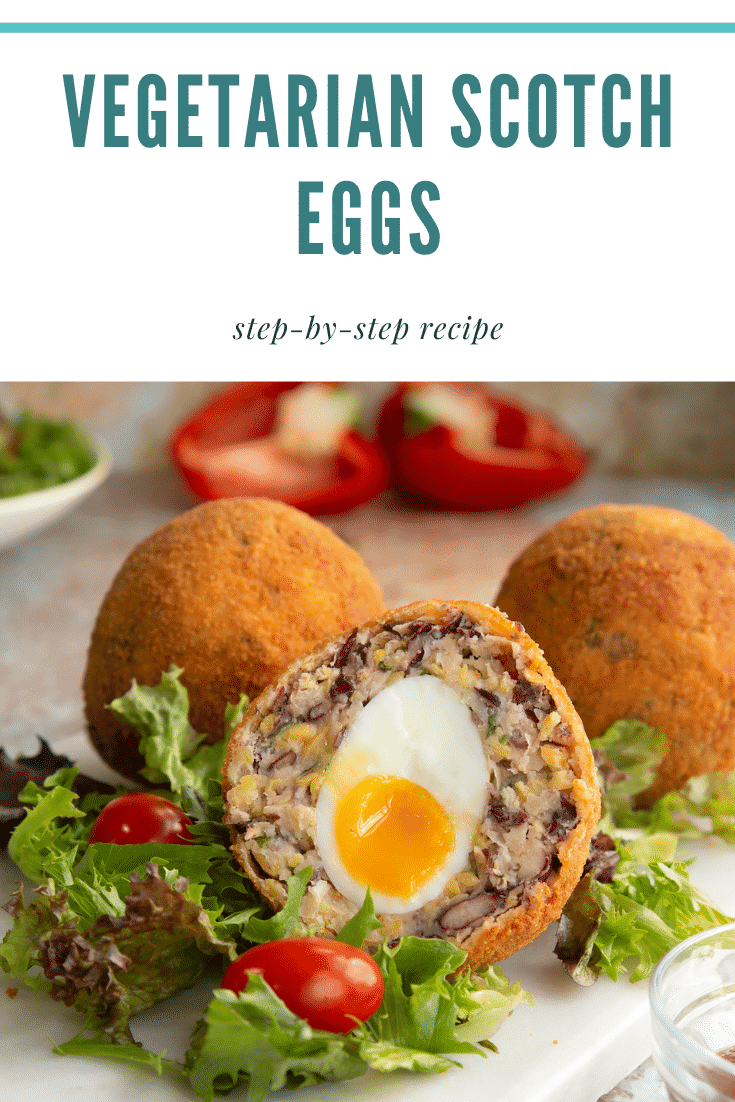
More meat-free snack recipes to try
Have you got my book?

'This is a great kids cookery book. Emily is a star' - Simon Rimmer
'The book I'd like to force into any mother's kitchen' - Prue Leith
"A fab book with a plan." - Jane Devonshire, 2016 Masterchef UK winner
'Emily has managed to combine her mummy knowledge and passion for food to make a truly helpful and brilliant cookbook' - Priya Tew, RD, BSc (Hons), Msc
Get Your Kids to Eat Anything is an achievable 'how to' for parents in the battle to overcome picky eating and 'make new the norm'. Emily Leary's unique 5-phase programme looks at the issue of 'fussy eating' in a holistic way that links imagination with food, and which situates parents alongside - not in opposition to - their children.



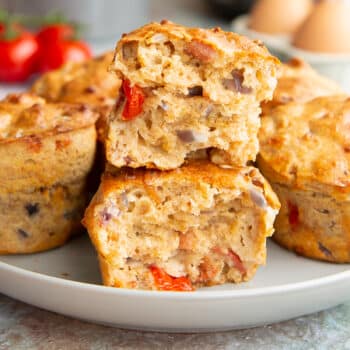



Jackie says
I've been eyeing up this recipe for a while and finally got round to making it. I used the exact quantities shown in the recipe, but felt there was far too much of the bean mixture as my four scotch eggs were HUGE. I think if I were to make this again I would use this quantity to cover six eggs. I hard-boiled the eggs as I only had 3 people to feed and would have to store the remaining one in the fridge for another day. Also as I'm a bit afraid of deep fat frying I baked them in the oven for 20 minutes, examined them, turned them over and gave them another 5 minutes and they were lovely and crispy. All in all a success, although the monster size was unexpected.
David says
Would it be better to combine the pulse mixture with egg also to help ot hold together?
Emily Leary says
That's not necessary in my experience :)
The Hungry Mum says
Just googled veggie scotch eggs and found this great recipe - I know what's for dinner tomorrow night :)
happiweb says
Exdcellent! I love the look of these.
Veggie Mama says
How very clever! I love it! Always wondered how to veggie up a scotch egg, and even found a recipe somewhere but have never done it. Yum.
TheBoyandMe says
They look *bloody* gorgeous! I am absolutely making them, but like I said earlier I'll need to mush the beans up a lot more. Thanks for this (pinning it!)
Midlife Singlemum says
Exdcellent! I love the look of these.
Fiona Maclean says
Looks good Em...and I don't even like eggs!
Chris says
Wow! Those Scotch eggs really look great. You don't notice at first glance it's no meat. It's good that there are no strange ingredients in the recipe, ingredients that pretend to be tasting like meat.